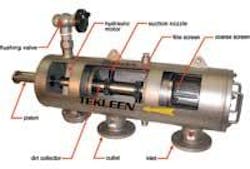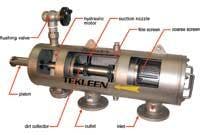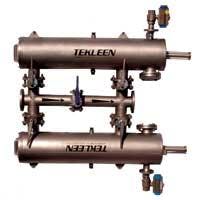Automatic Self-Cleaning Filters Tackle Sandy Water
Arizona is one of the fastest growing states in the country, second only to its neighbor, Nevada. Since 1990, the population there has increased by more than 50 percent. It is also one of the driest. The three and a half million people living in the Phoenix area, 60 percent of the state’s residents, can expect to see a total of eight inches of rain a year. Living in a place like that, you have to make the most of any available water.
Two hours north of Phoenix, in the City of Flagstaff, it is a bit less severe. At an elevation of 7000 feet, the temperatures are cooler and the rain is more plentiful, though it is still half of what you would get in New York or Chicago. So, in addition to conservation measures such as limiting lawn watering and expanding the use of reclaimed water, the city also relies on seasonal water sources that require special filtering to meet water quality standards.
The city currently uses about 9000 acre feet (approximately three billion gallons) of water annually. It gets this water from seven different sources, depending on availability. The largest source is surface water from Lake Mary, which can provide up to 7.5 million gallons daily. Lake water is used extensively when the lake is above 50 percent capacity. There are also three well fields, one of which is only available in the summer, providing up to another 12 mgd. Recently, two wells were drilled within the city limits which can provide another million gallons of water per day when needed.
According to Jack Rathjen, Flagstaff’s water production supervisor, each water source has its own type of filtering mechanism to bring the water up to standard. Water from Lake Mary is treated and filtered conventionally. The well fields have sand clarifiers, where the water can sit, allowing sand particles to settle out and entrained air to escape before it is sent into the distribution system. This system wouldn’t work, however, for the two local wells at Foxglenn and Continental because they are pumped under pressure straight into the distribution system without passing through a clarifier.
“These two wells were designed to go directly into the system without having to go through any storage or clarification,” Rathjen explains. “If we could slow the water down long enough, the sand would settle out and the gasses escape, but in this application we were pumping directly from the wells into the distribution system so we didn’t have that opportunity.”
The Utilities Department decided to use membrane air separators to extract the entrained air from the water. But this brought up another problem - the sand.
“These sands are silica and can abrade the membrane fabric,” Rathjen said. “We didn’t want that to happen, so we put a filter ahead of the membranes.”
Whenever a reverse osmosis (RO) filtration system is used, a prefilter should be used to bring the Silt Density Index (SDI) down to an acceptable level. SDI is a simple filter test used to determine quality of RO feedwater. This test employs a dead end filtration method to simulate the cross-flow pattern that exists in the RO systems. It is recognized throughout the industry as a good yardstick for the acceptability of RO feedwater.
Most membrane manufacturers specify that the SDI should be less than or equal to 5, but a more conservative SDI value of three is preferable. Using water with an SDI higher than three can lead to frequent membrane cleaning, increased permeate quality degradation over time and shortening of membrane life.
Elevated SDI needs to be investigated and properly addressed during the design stage. Often improper coagulant dosage and pH adjustment (particularly with alum) may cause flocculation to take place downstream of the filtration process. Furthermore, inadequate backwashing may contribute to the poor performance of the filter system. Additional filtration (polishing filter) with fine filtering media installed prior to the RO can improve the SDI considerably.
Flagstaff’s initial solution to its membrane problem was to use two high capacity canister vessels at each site containing 50 cartridge filters each. These filters did an adequate job of removing the sand and preserving the membranes, but they were not ideal. To begin with, it proved time consuming to go into the canisters and manually clean the fouled cartridges when needed. In addition, the cartridges needed replacement every two to three months.
“The cartridge filter system was labor intensive and it cost a lot for all those little cartridges,” Rathjen said.
To eliminate this problem, Rathjen replaced the existing canister filters with self-cleaning, automatic backwash filters. He evaluated products available from two manufacturers before settling on Tekleen units from Automatic Filters Inc.
“The Tekleen filters were less expensive and their technology is pretty simple,” he said.
The filters come in sizes ranging from 10 gpm to 12,000 gpm and screen sizes as small as five microns. What sets Tekleen filters apart, however, is the self-cleaning mechanism that allows a continuous flow of filtered water while the cleaning takes place. The procedure also uses a fraction of the water that normal back-flushing requires.
In the Tekleen design, the dirty water flows in around the outside of a coarse filter which removes the larger particles. This prefiltered water then flows to the other end of the filter housing where it passes from the inside to the outside of the final filter and then through the outlet. Over time, as the filter removes particles from the water, those particles clog the filter, reducing water flow and water pressure. At the outlet is an adjustable pressure differential switch, typically set at five to seven pounds. When that threshold is crossed, it opens the small flush valve which initiates the cleaning procedure.
Rather than taking the full water flow to initiate a complete backwash, the Tekleen filters have a number of small cleaning nozzles arrayed around a central shaft. When the flush valve opens, this lowers the water pressure within the cleaning unit, and the nozzles vacuum the dirt from the inside surface of the filter screen. A hydraulic motor and piston cause the nozzles to rotate and move axially in order to cover the entire screen surface. At that point the flush valve closes and the cleaning mechanism returns to its starting position.
Depending on the size of the model, the entire procedure lasts about five to ten seconds and, since it is only cleaning a small portion of the filter screen at any given moment, water filtration continues uninterrupted. Other than a small control voltage for the differential pressure sensor and to actuate the flush valve, all motions involved in cleaning the filter are performed using water pressure.
Rathjen installed two ABW4-LP filters in parallel at each site. The filter contains a five square foot stainless steel screen. Due to the fineness of the sand in the well water, he selected the smallest screen size then available - 10 micron. (5 micron screen is now available.) These models fit on 4" water lines and have a maximum flow of 200 gpm with the 10 micron screen, up to 500 gpm with larger mesh sizes, so two filters were enough to accommodate the 350 gpm flow from each well. Since the filters are about five feet long horizontally, the piping needed to be redone to fit the new filters.
The Tekleen filters have now been operating without problem since 2000. The water at both well sites is very hard (243 hardness at Foxglenn) and so every six months or so he gives the filters an acid wash to remove the calcium deposits and improve the water flow. But other than that, they just sit there doing their job of protecting the membranes without a lot of additional expense or maintenance.
“Overall, the filters do what we bought them to do, which is to get the sand out and protect those membrane contactors,” Rathjen said.
Tekleen filters are manufactured by Automatic Filters Inc. of Los Angeles, CA, and are available in a variety of sizes and configurations. For more information, contact the manufacturer at 310-839-2828 or visit its website, www.tekleen.com.


